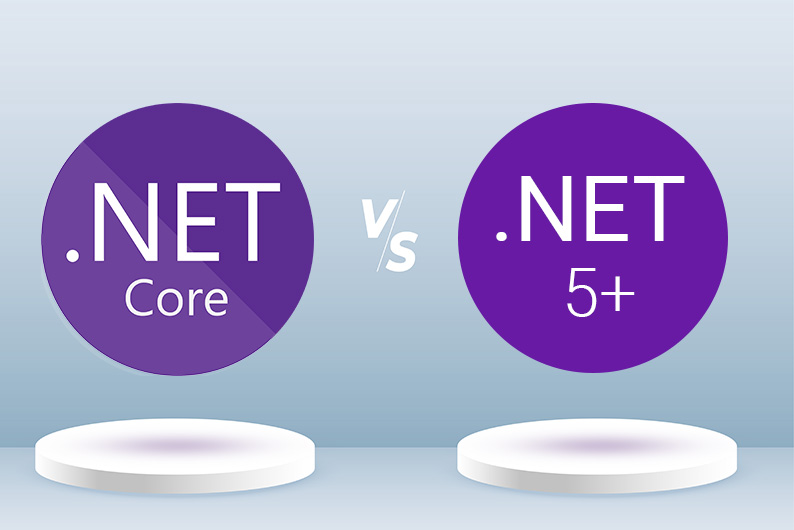.NET 6, launched in November 2021, stands as the latest iteration of the .NET framework, bringing forth substantial improvements and introducing notable features. In this discussion, we explore the recent updates and additions unveiled in .NET 6.0.
This convergence extends beyond conceptual boundaries; a shared foundation of base class libraries, APIs, and fundamental infrastructure, including languages and compilers, underpins all these diverse application domains.

This holistic approach signifies a crucial step toward creating a versatile, inclusive platform catering to the multifaceted needs of modern software development. Let’s get familiar with- What’s new in .NET 6.
Key Highlights
Before getting .NET development services understand its key highlights and accessibility:
- Unified Development Landscape: The shift from .NET Framework and .NET Core to .NET 6 streamlines the developer experience by providing a singular, cohesive development environment.
- Versatility Across Platforms: .NET 6 extends its reach across various platforms, including Windows, Linux, and macOS, fostering a genuinely cross-platform development experience.
- Comprehensive Application Development: Developers can leverage .NET 6 to build applications for a broad spectrum of domains, from cloud-based solutions to desktop applications, mobile experiences, gaming projects, and ventures into emerging technologies like IoT and AI.
- Shared Infrastructure: The commonality in base class libraries, APIs, and infrastructure ensures consistency and ease of development across the diverse application landscape.
New added Features in .NET 6
Let us understand the .NET 6 features & enhancements which has taken the market by surprise:
1. Improved Performance
Performance is a cornerstone of .NET 6, with significant enhancements across various aspects. Notably, file I/O has seen substantial improvements, leading to reduced execution time, latency, and memory usage. The revamping of the FileStream class, particularly in async file I/O, has made operations several times faster. System types like Guid and string have undergone considerable enhancements, further optimizing the runtime environment.
2. Profile-Guided Optimizing (PGO)
A novel feature introduced in .NET 6 is Profile-Guided Optimizing (PGO), a compiler optimization technique. PGO enables the JIT compiler to generate optimized code based on the types and code paths that are most frequently used. This adaptive approach to optimization ensures that the application’s performance is tailored to its specific usage patterns, enhancing overall efficiency.
3. Unified Platform Support
Continuing the groundwork established by .NET 5, .NET 6 marks a significant milestone in Microsoft’s pursuit of a cohesive platform. This objective revolves around offering a consistent development platform, enabling seamless execution of applications across diverse operating systems and devices. The unification encompasses web browsers, desktop apps, cloud environments, IoT devices, and mobile platforms, ensuring that all .NET 6 applications leverage the same array of .NET libraries.
4. New APIs
.NET 6 incorporates an array of novel APIs that encompass key domains like HTTP/3, JSON, and mathematics. By integrating these updates, .NET amplifies its prowess and adapts to the continuously changing requirements of developers. This accommodation not only encourages innovation by Software Development Companies but also enhances efficiency in the development of applications.
5. Security Improvements
Security remains a top priority in. NET 6 features & enhancements, with notable enhancements. Support for the ChaCha20Poly1305 encryption scheme, integration with OpenSSL, and the implementation of “defense in depth” runtime mitigations contribute to a more robust and secure framework.
6. Language Improvements (C# 10 and F# 6)
C# 10 introduces several improvements, including new lambda capabilities, record structs, and implicit using. These enhancements empower developers to write cleaner and more expressive code. Similarly, F# 6 sees improvements such as pipeline debugging and Task-based async, providing additional tools for functional programming.
7. JSON APIs Enhancements
The JSON APIs in .NET 6 have undergone significant improvements, introducing a new source generator for System.Text.Json. This eliminates the need for runtime reflection and code creation, resulting in improved performance and more efficient serialization code generated at build time. You can choose IntelliSource for getting these services in a budget friendly cost.
8. Cloud Diagnostics
Cloud diagnostics receive a boost in .NET 6 with the integration of OpenTelemetry and dotnet-monitor. These additions enhance the diagnostic capabilities of applications, particularly when deployed on Azure App Service, providing valuable insights for monitoring and troubleshooting.
9. Code Quality Improvements
To assist developers in writing better, safer, and faster code, .NET 6 introduces source generators and analyzers.
10. DateOnly and TimeOnly Structs
A long-awaited feature in .NET, the introduction of DateOnly and TimeOnly structs enables developers to work with objects that represent only date or time values. This brings greater flexibility and precision to date and time manipulations in applications.
11. Support for Async Streaming
.NET 6 introduces support for async streaming through IAsyncEnumerable<T>. This feature allows developers to stream data from the server without buffering, providing more efficient and responsive handling of streaming scenarios.
Key Differences between .NET6 and .NET 5
The evolution from .NET 5 to .NET 6 signifies a substantial progression in the realm of application development, building upon the foundations laid by .NET Core 3.1 and .NET 4.6. Although .NET 5 exhibits some semblance to its successor, .NET 6, they are distinctly different entities, each offering unique features and enhancements. Here’s a comprehensive comparison to shed light on their divergent attributes and What’s new in .NET 6:
1. Programming Languages
.NET 5: Equipped with C# 9 and F# 5, providing developers with the latest language features.
.NET 6: Introduces C# 10 and retains support for C# 6, offering advanced capabilities and language enhancements.
2. Platforms
.NET 5: Supported on Windows, Linux, Android, iOS/tvOS, and macOS.
.NET 6: Extends support to Windows Arms64 and macOS Apple Silicon, broadening the spectrum of compatible platforms.
3. Integrated Development Environment (IDE)
.NET 5: Compatible with Visual Studio 2019 (version 16.8 or later versions).
.NET 6: Requires Visual Studio 2022 and Visual Studio 2022 for MAC, necessitating an upgrade for developers.
4. Open-Source Commitment
Both .NET 5 and .NET 6: Embrace the principles of open-source development, fostering collaboration and transparency.
5. Support Lifecycle
.NET 5:Reaches end-of-support on May 8, 2022, with no further servicing updates, technical support, or security fixes.
.NET 6: Positioned as a long-term support (LTS) framework, ensuring continuous support for three years.
6. Speed
.NET 5: Runs relatively fast, catering to efficient application performance.
.NET 6: Emerges as the fastest iteration among all .NET versions, setting a new benchmark for application execution speed.
In essence, the transition from .NET 5 to .NET 6 signifies a journey of evolution and refinement. While .NET 5 serves as a foundational step with notable advancements, .NET 6 emerges as a culmination of progress, offering enhanced language features, extended platform support, and a commitment to long-term stability. Developers navigating this landscape can choose based on their specific requirements, with .NET 6 standing out as a beacon of innovation and performance in the .NET ecosystem.
Revolutionizing Development with .NET 6 Hot Reload
In the ever-evolving landscape of modern development, swift feedback is the linchpin of efficiency. The duration between a code change and its manifestation in the application’s output can significantly impact the development workflow. Enter the .NET 6 Hot Reload feature, a game-changer unveiled in .NET 6 Preview 3.
Hot Reload empowers developers to modify the user interface on-the-fly while the application is actively running. This transformative capability allows for a diverse array of code edits without the need to endure the customary waits associated with app restarts, rebuilds, or re-navigations after making code changes.
The accessibility of the Hot Reload feature extends to both Visual Studio 2022 and the dotnet watch CLI tool. What’s more, it seamlessly integrates with a broad spectrum of application types, spanning from Blazor to ASP.NET Core and WinUI 3.
When utilizing Visual Studio 2022, developers can initiate their .NET 6 app, implement a supported edit, and then utilize the newly introduced “Hot Reload” button to apply changes. Alternatively, changes can be applied on save through the drop-down menu on the same button, offering flexibility in the development process.
For those leveraging the CLI, the process remains akin to Visual Studio Code. Launch the app using `dotnet watch`, make supported changes, and witness instant application of changes upon saving the file. In the event that the edits are unsupported, detailed feedback is logged to the command window, providing clarity to developers.
.NET 6 Hot Reload stands out for its simplicity and accessibility, making it an invaluable tool even for novice coders. As it becomes an integral part of the development toolkit, Hot Reload promises to redefine the development experience by enabling real-time UI modifications and fostering a more seamless and responsive workflow.
.NET 6 is a comprehensive release that not only addresses performance concerns but also introduces a plethora of features and improvements spanning language enhancements, security, cloud diagnostics, and developer tools. With a focus on unification, adaptability, and enhanced developer experience, .NET 6 sets the stage for efficient and modern application development across diverse platforms.
With its unified platform, enhanced language capabilities, and refined developer tools, .NET 6 emerges as the go-to Microsoft development platform, poised to shape the landscape of application development for years to come. Microsoft .NET 6 not only signifies its launch but also sets the pathway for the progress of .NET platforms. With a robust framework established, it enables developers to craft pioneering applications that provide outstanding performance across various operating systems and architectures within the .NET ecosystem.

